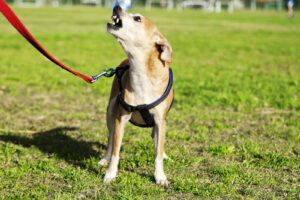Barks Blog
A Positive Outlook on Canine Aggression

It usually starts when I receive a call from a distressed client who informs me that their dog is, or has, suddenly turned ‘aggressive.’ They tell me their dog has ‘challenged’ them in some way: baring teeth, snarling, growling or may have even bitten (with various degrees of severity). Then, when I first meet with that client, they are usually in quite a state because they think their whole mutual loving and trusting relationship with their dog has been shattered, their dog has flipped personality. Some even feel scared of their canine friend.
Think Reactivity Not Aggression
One of the very first steps I take with clients is to replace the word ‘aggression’ with reactivity. Aggression is a big scary word with lots of negative associations. There are multiple forms of aggression and the very mention of it conjures numerous abhorrent mental images and essentially brands the dog. Reactivity says ‘okay, my dog is uncomfortable in a specific situation, let’s do something about that’ – there are less pessimistic associations concerning that word.
What Does ‘Reactivity’ Mean?
Often, a dog does not want to show any sign of reactivity at all – this is a last resort, a response to an uncomfortable situation or event. If at all possible, the dog will avoid both of these. Reactivity is absolutely not about being ‘dominant’ or trying to ‘control’ you or a situation; it is merely a response to a given context.
Think Communication Not Punishment
Many of the owners I see have reacted upon impulse when they see their dog reacting. Maybe he’s been snarling, growling, showing his teeth or even bitten. Their response has been to shout, smack, pin the dog down or to use similar forms of physical punishment. It is difficult for them to resist ‘dominating’ the dog or ‘letting him get away with it’. In these cases, the issue is gentle education. We have to think back. Rather than immediately act upon impulse and literally strike out, stop and think – those multiple symptoms of reactivity (snarling, growling, showing teeth etc.) are actually a form of communication. Think, what was I doing in that given situation that actually made my dog react in that way and what was he signalling to me?
Signalling is Good!
Yes (in this context) those symptoms of reactivity are good. But only if you react to them in the right way.
There is a subtle progression of reactive symptoms which Kendal Shepherd (2004) depicted as a Ladder of Aggression. If appeasement behaviour is misunderstood and ignored, reactivity can be created.
How a dog is treated for early exhibitions of reactivity is also crucial. Should a dog be punished for exhibitions of reactivity on lower rungs of the ladder (snarling, growling for example), he may progress quickly to biting – resulting in an owner reporting the dog for exhibiting unpredictable aggression. It’s not ‘unpredictable aggression’, it’s just that unfortunately the owner has missed all those opportunities to remove the dog from the uncomfortable situation and subtle canine communication cues – ‘get me out of here/stop this please’ prior to right now when the dog is left with no choice but to halt the interaction with physical contact.
For these reasons, ‘red flag’ signals (especially those very early subtle, first rungs on the ladder ones) should be taken as a positive since they are a clear communication of your dog not being comfortable with a situation.
So…What to Do?
Let’s say maybe your dog begins to display signs of reactivity, what should you do? Well the first thing is not to panic! Following this, make contact with a fully qualified, accredited and force-free behaviour consultant. It is also wise, if your behaviour consultant does not initially direct you, to make an appointment with your vet.
Signs of reactivity, especially if they are sudden, may be related to (not exhaustive):
- Pain (acute or chronic, especially in older pets)
- Sensory impairments (again especially in older pets)
- Cognitive decline in older pets
- Neurological issues
- Endocrine disorders
- Skin irritation
- Parasites
Health and medical issues can exert much influence upon behaviour, so your first step is to rule this contributory factor in or out.
My Dog Has a Clean Bill of Health – Now What?
Great news! Now the focus is upon changing your dog’s emotional response to what upsets him. A qualified behaviourist will work to alter how your dog feels in uncomfortable situations.
- First steps are to remove any form of punishment
- Next we work to identify all triggers of reactivity and antecedents of that reactivity, however insignificant they may be
- Progression then moves to a precise examination of every reactive incident, the what, where, how, if, when etc. in order to determine patterns, cause, predictability etc.
- Likely behavioural techniques will include desensitization, counter-conditioning and response substitution
Find the Motivation
Of course, this is a very short resume of a treatment plan for reactivity because it is important to understand that every dog will require a totally different approach. Two dogs may present with a dislike of being touched around the head and bite their owner when a collar is put on but ‘Dog A’ may have been struck and have conditioned fear of the approach and ‘Dog B’ may have had chronic otitis and learned that the approach is painful – motivation is different. Treatment plans therefore will vary according to the individual even though presentation may look similar.
The Outlook is Good!
As can be seen, reactivity is not a simplistic matter and is very individualistic. But..great news is that with the aid of a qualified force free professional, the vast majority of cases can be aided and go on to live a full and happy life.
